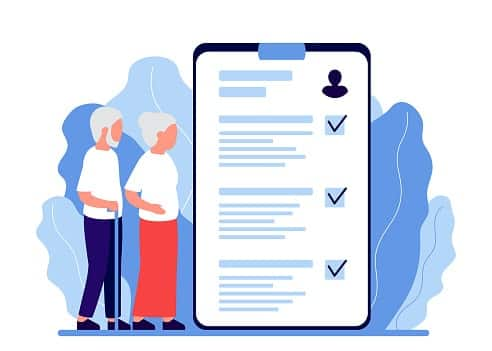Tips for finding affordable long-term care insurance
The following steps can help you reduce the cost of long-term care insurance while still providing valuable coverage.
Don't cover the full cost of care
Around one-third of people don't need long-term care at all during their lifetimes, and some only need a short period of care in their homes. Rather than buying enough insurance to cover the worst-case scenario, it can help to buy insurance to help pay some of the bills if you need long-term care, but to also be prepared to pay a portion of the cost from your savings and income.
"Most people I'm working with are looking to cover 50% to 75% of the cost of care," says Brian Gordon, president of MAGA Long-Term Care Planning in Bannockburn, Illinois. For example, they may decide to get $3,000 per month in coverage for three years, with benefits rising 3% per year compounded - that will start out as slightly more than $100,000 in benefits and rise with inflation. It may not cover the full cost of care, but it can help with the expenses. "They may decide that at least it gives their family some money to work with if something happens," says Gordon. "A big mistake is to try to buy more benefits and try to cover everything, but my goal is to give the family some good monthly income to work with if something happens to them."
To figure out how much coverage to get, find out how much long-term care costs in your area. You can look up median costs by city and state in the Genworth Cost of Care survey. Then calculate how much you could afford to pay from your savings and income, and you buy just enough long-term care insurance to fill in the gap.
Buy coverage with a spouse or partner
"When you have two people buying the policies, some insurers give substantial discounts for the couple," says Gordon. You may get a discount of up to 30% if both partners apply for long-term care insurance, or you may even get a discount of up to 15% just for being married or having a partner, even if only one applies for coverage, says Gordon.
A 55-year-old couple who buys a policy with a $4,500 monthly benefit for three years and 3% compound inflation would pay $3,050 on average, even though a single man would pay $1,700 and a single woman would pay $2,675, according to the American Association for Long-Term Care Insurance.
If you're buying coverage together, you could also save money - and hedge your bets - with a shared-benefit policy. The average need for care is three years, but some people end up needing no care at all, while others need care for much longer if they have a long-lasting condition like Alzheimer's. With a shared-benefit policy, you get a pool of benefits that you can share between both spouses. For example, instead of each buying a four-year benefit period, you have eight years between the two of you. Adding the ability to share benefits can increase your premiums by 10-15%, but it may make you more comfortable buying a shorter benefit period - such as three years rather than four or five years - which could ultimately save you money and provide more coverage for the spouse who needs it.
Consider coverage when you're in your 50s or early 60s - or even younger
The younger you are when you buy the policy, the lower your annual premiums will be. And if you're younger, you're less likely to have medical conditions that make it more difficult to qualify for coverage or find affordable rates. For example, a single 55-year-old man who buys a policy with a $180,000 pool of benefits that doesn't grow with inflation would pay about $875 per year for coverage. But a 65-year-old man who buys a $162,000 pool of benefits would pay $1,400 per year in preferred health, but $2,100 per year if he has some health issues.
Buying coverage in your late 40s or 50s might be perfect timing if you are no longer supporting your kids and have more money to set aside for your own future. Keep in mind that the insurer could increase premiums for all policyholders before you need care, so you need to build that possibility into your budget, too.
Make smart inflation adjustment decisions
Most people need long-term care in their 80s, so you may have the policy for 20 years or more before it starts to pay out. It's important to make sure the benefits increase with inflation, so they can keep up with the rising cost of care. In the past, most people bought policies that increased the benefits by 5% compounded each year, but those policies have become incredibly expensive - especially now that the interest rates for insurers' investments are so low. Instead, 3% compound inflation protection is becoming the standard. At 3% compounded, the benefits can grow substantially through time - the pool of benefits that starts at $164,000 for the 55-year-old will grow to $386,000 by age 85, according to the American Association for Long-Term Care Insurance.
Find out what other inflation options the insurer offers. If 3% compound inflation protection costs too much, you may want to consider starting with a larger monthly benefit with a 3% simple inflation adjustment, which still increases the value of your coverage but costs less. Or you may have the option to have 3% compound inflation continue for just 20 years rather than for your lifetime.
Choose the waiting period carefully
You may have a choice of several elimination periods - such as 30, 60, 90, or 180 days - which is the waiting period before benefits kick in. The longer the waiting period, the lower your premiums. But keep in mind that you need to pay for the care out of your pocket first - if you have a $200 daily benefit and a 90-day elimination period, you may need to pay $18,000 yourself (or more with inflation adjustments) before the policy pays benefits.
A 60-day elimination period tends to be a good balance of cost savings vs. potential out-of-pocket costs.
Also, find out whether the waiting period for home care is the same. Some policies have a 0-day waiting period for home care but a longer waiting period for assisted living and nursing home care. If you think you'll start by receiving care in your home - which is how most claims begin - then the 0-day waiting period for home care can save you money in out-of-pocket costs.
Tax-efficient tips for paying long-term care insurance premiums
Several tax breaks can help you stretch your money to pay for long-term care insurance.
Use tax-free money from a health savings account
If you have a health savings account, you can withdraw money tax-free to pay long-term care insurance premiums based on your age - in 2022, you can withdraw up to $450 if you're 40 or younger, $850 for age 41 to 50, up to $1,690 for age 51 to 60, up to $4,510 for age 61 to 70, and up to $5,640 if you're older than 70. Those limits are per person. Spouses who both pay long-term care premiums can each take tax-free withdrawals up to those limits based on their ages. The long-term care policy must be tax-qualified, which includes most standalone policies.
Deduct long-term care premiums as a medical expense
If you itemize your income-tax deductions, you can include a portion of your long-term care premiums as a tax-deductible medical expense - up to the same limits based on age as the HSA withdrawals. Medical expenses are only deductible after they exceed 7.5% of your adjusted gross income. You can't take the tax deduction if you took tax-free HSA withdrawals for the premiums. For more information, see IRS Publication 502, Medical and Dental Expenses.
Make a tax-free rollover from life insurance or an annuity
You can roll over the cash value from a permanent life insurance policy or an annuity tax-free to pay long-term care insurance premiums, a process called a "1035 exchange." This can be helpful if your kids are grown and your house is paid off and you need long-term care more than you need a life insurance policy. Or you can use the cash value to pay premiums for a hybrid policy that provides both long-term care coverage and life insurance -- if you don't need care (or only need some care), the policy provides a death benefit for your heirs. You can also roll over money from an annuity, even if you're in poor health, to pay long-term care insurance premiums without paying taxes on the withdrawal first. Contact your insurance company or agent about the procedure for making the tax-free rollover.




